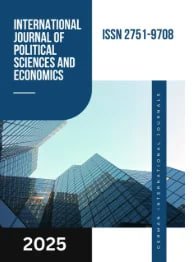CENTRAL ASIA IN GLOBAL ENERGY MARKETS: GEOPOLITICAL RISKS AND ECONOMIC OPPORTUNITIES
DOI:
https://doi.org/10.55640/Keywords:
central Asia, global energy markets, geopolitics, energy security, renewable energy, energy transition, infrastructure, regional cooperation, green hydrogen, climate risk.Abstract
This article analyzes the evolving role of Central Asia in global energy markets, highlighting both the economic opportunities and geopolitical risks facing the region. It explores the energy potential of Kazakhstan, Uzbekistan, Turkmenistan, Kyrgyzstan, and Tajikistan—including oil, natural gas, hydropower, and renewables—while examining their strategic importance as energy exporters and transit hubs. The piece discusses the impact of rising domestic energy demand, aging infrastructure, and external dependencies, particularly on Russia and China. It also considers the region’s growing relevance to the European Union and global green transition efforts. By addressing challenges such as political instability, climate vulnerability, and infrastructure gaps, the article offers a comprehensive overview of Central Asia’s prospects in the shifting global energy order.
References
1.ADB. (2021). Uzbekistan: Energy Sector Assessment, Strategy, and Road Map. Asian Development Bank. https://www.adb.org/documents/uzbekistan-energy-assessment-strategy-road-map
2.Badykova, N. (2021). Energy security in Central Asia: Infrastructure and risk. Real Instituto Elcano. https://www.realinstitutoelcano.org/en/analyses/energy-security-in-central-asia-infrastructure-and-risk-ari/
3.Buranelli, F. C. (2021). The Eurasian Economic Union and the Silk Road Economic Belt: Complementary or competing projects? Central Asian Survey, 40(2), 204–222. https://doi.org/10.1080/02634937.2021.1875464
4.Energy Charter Secretariat. (2018). Energy Investment Risk Assessment (EIRA): Kazakhstan and Uzbekistan Country Profiles. https://www.energycharter.org/what-we-do/eira/
5.Farrell, H., & Newman, A. L. (2019). Weaponized interdependence: How global economic networks shape state coercion. International Security, 44(1), 42–79. https://doi.org/10.1162/isec_a_00351
6.IRENA. (2022). Renewable Energy Market Analysis: Central Asia. International Renewable Energy Agency. https://www.irena.org/publications/2022/Nov/Renewable-Energy-Market-Analysis-Central-Asia
7.Kassenova, N. (2022). Kazakhstan’s balancing act: Energy, security, and sovereignty. Carnegie Endowment for International Peace. https://carnegieendowment.org/2022/07/11/kazakhstan-s-balancing-act-energy-security-and-sovereignty-pub-87410
8.Karatnycky, A. (2023). Russia’s energy diplomacy in Central Asia: A tool of influence or a liability? SpecialEurasia. https://www.specialeurasia.com/2023/03/13/geopolitics-gas-central-asia/
9.Kienzler, H., & Overland, I. (2021). Renewable energy in Central Asia: Progress, challenges, and opportunities. Energy, Sustainability and Society, 11(1), 1–13. https://doi.org/10.1186/s13705-021-00324-2
10.Melvin, N. (2020). The New Geopolitics of Central Asia: China's Rise and the Future of Regional Order. Stockholm International Peace Research Institute (SIPRI). https://www.sipri.org/publications/2020/new-geopolitics-central-asia
Published
Issue
Section
License

This work is licensed under a Creative Commons Attribution 4.0 International License.
Authors retain the copyright of their manuscripts, and all Open Access articles are disseminated under the terms of the Creative Commons Attribution License 4.0 (CC-BY), which licenses unrestricted use, distribution, and reproduction in any medium, provided that the original work is appropriately cited. The use of general descriptive names, trade names, trademarks, and so forth in this publication, even if not specifically identified, does not imply that these names are not protected by the relevant laws and regulations.







